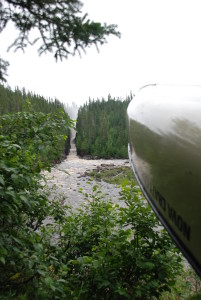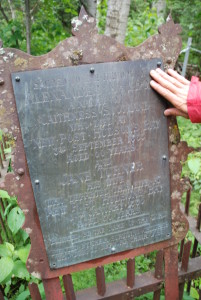Hudson Bay Cemetery – Heritage Matters
Hudson Bay Co. Outpost Cemetery – Heritage Lesson of Research and Determination
Abandoned – Not Forgotten Cemetery
Genealogy – Tracing Heritage – One Person – Our Heritage
by Back Roads Bill
Found it.

Approach to New Post Falls
The first thing you notice as you climb the clay river bank is the rhubarb, lilac bushes and Forget-me-not plants, not native to the boreal forest. Someone once lived here for sure, an initial impression and sense of place.
It is not far from a destination where you will enjoy a breathtaking vista, a towering gorge and revel in the sounds of the roaring water as it plunges into a pool many tens of metres below. In the background you can hear the sound of heavy machinery working in a wilderness environment; it is the noise of progress near New Post Falls.
Because of the narrow gorge it has a great deal of mist. One of the most scenic accessible but unknown waterfalls is now changing and it is going back to what it once was. Construction has started on the new hydroelectric development that will affect the flow of water plunging over the crest of the cataract. That was last week’s story, but now we go further back in time and to another place nearby the falls.
Genealogy is a curiosity for most, a hobby for many and an obsession for some. There is the practical side of genealogy such as tracing ownership or cultural identification. There are also the philosophical aspects of human curiosity including the desire to carve out a place for one’s family in the larger historical picture, a sense of responsibility to preserve the past for future generations and a sense of self-satisfaction in accurate storytelling. The abandoned graveyard at the former Hudson Bay Company (HBC) outpost is a place of wilderness. Through the tall grass and dense new growth to the elevated ground, there it is; you start to read the inscriptions.
The Historic Context
Canada seems to have more geography than history but the HBC is huge part of what we know about our heritage. For generations’ fur traders scratched out a living in the North American wilderness, the HBC dominated the landscape through a commercial empire and a network of outposts. At one time the HBC encompassed an area ten times that of the Holy Roman Empire.
 The employees of the HBC lived with our “first peoples” and the impact of the wrongdoings is well documented. It included: “…accepted the fact that liquor was part of their necessary operations…”; “…they became citizens of the New Land, in the early years mating with the Indian tribes with whom they traded,” and “More serious medical complaints included ‘country disorder” (a form of fever combined catarrh) and syphilis. (pp. 161, 7 and 159 ‘Company of Adventurers,’ Peter C. Newman, 1985, Penguin Books).
The employees of the HBC lived with our “first peoples” and the impact of the wrongdoings is well documented. It included: “…accepted the fact that liquor was part of their necessary operations…”; “…they became citizens of the New Land, in the early years mating with the Indian tribes with whom they traded,” and “More serious medical complaints included ‘country disorder” (a form of fever combined catarrh) and syphilis. (pp. 161, 7 and 159 ‘Company of Adventurers,’ Peter C. Newman, 1985, Penguin Books).
It was said by the Canadian author, “The Hudson Bay Company is probably the best documented institution in the world next to the Vatican.” It is true they kept meticulous records, almost obsessive to the point of accounting details. Maybe that is why the HBC was so successful (?).
Google searches often only lead to generalities; it is then time to practice good library and journalism skills learned once upon a time in a faraway land. It is a satisfying day when you eventually find and secure the information you were looking for. In this case, from the Hudson’s Bay Company Archives, (Provincial Archives of Manitoba) Archives’ Assistant, Marie Reidke, in Winnipeg; a scanned copy of HBCA PP5288 – ‘New Post History: Hudson’s Bay Company Post on the Abitibi River, Ontario.’ Wow, (thanks are given) more discoveries follow.
New Post site was operational from 1857 until 1924 half way between Moose Factory and Abitibi Lake. This post possessed four buildings, a factor’s (manager) residence, a second house occupied by a Native family, a general trading store and a storehouse. “A dozen tents or teepees indicated that about twelve hunters were dependent on the post.” You begin to get stuck within the world of words.
From the turn of the last century, visiting geologist to New Post, William Arthur Parks writes: “New Post is the only trading station of the HBC on the Abitibi and is the only place where supplies of any kind can be obtained from Fort Abitibi and Moose Factory. Mr. Jobson’s son, the factor in charge, has a flourishing garden in which are turnips, onions, potatoes, corn cabbage, lettuce and radishes all doing well. Early red potatoes were rotting on the ground, but white varieties do well; 300 bushels were grown here last year. Corn will ripen some years, but it fails on other occasions. Mr. Jobson has several head of cattle, the winter fodder for which is gathered by the Indians, and consists of the marsh grass abundant along the river. The soil is fine, argillaceous (dictionary -clay) in places. As an example of the vagaries of the rivers, Mr. Jobson informed me that in the spring of 1897 the water rose to the foundation of his house, a distance of 29 feet. The Indians attached to the post are rapidly succumbing to the attacks of consumption and scrofulous (dictionary – having a rundown appearance or morally contaminated) disease and owing to the decrease of partridge and rabbit are sometimes at sore straights for food. As the rabbit fails the lynx also disappears for want of prey, while the beaver is almost hunted out in this district.”
And within a 1970’s excerpt from a report by ‘Woodland Heritage,’ archaeologist, John Pollock (Timiskaming Shores resident) it states, “Indians (sic) who traded at New Post had a large system of family hunting territories that covered the east of the Abitibi River.” You now have historic impressions and interpretations, by visitors and professionals, snapshots or tidbits of life there.
The Research
There are a number of compelling headstones and unmarked graves at the New Post site. But there is one and only one iron fence and iron marker at the site; it is a headstone with the following: “Sacred to the memory of Alexander McLeod – a native of Caithness Scotland – who died at New Post Hudson’s Bay – 3rd September 1885 –aged 60 years- and Jane Turner – his wife – who this life at New Post Hudson’s Bay – 19th January 1886 –aged 50 years – blessed by the name of the Lord – erected by their surviving children – who deeply deplore their loss.” Who is Alexander McLeod – someone special? Caithness is one of the Orkney Islands where most of the HBC originated from; called “Bay men” their new existence was fairly bearable when compared to their homeland and besides that, they now had jobs. The pursuit to find out begins. It takes a while and the hunt for information is only sustainable by interest. The surname McLeod is a common to Cree First Nations in the north as is Turner and Linklater, stemming from HBC employees. The real problem was to sort out the masses of names.
After finding, joining and researching on Red River Ancestry.ca it was learned Alexander McLeod (and there were many to sift through) was the factor from 1870 until his death. He began to work for the HBC at age seventeen as a clerk in Turner Valley, Alberta. He married Jane Turner and they had 13 children. In 1849 he was put in charge of the Abitibi House Post on Lake Abitibi and then to New Post; completing 43 years of service. Anecdotally, within the New Post archival document it is known supplies were brought to the post by York boats and freighter canoes. His son, George, born at Abitibi, (Oct. 16, 1891) moves with his family to New Post as age eleven. At age 15 he was sent to Moose Factory to become an apprentice.
George eventually becomes a carpenter and assumes a variety of company positions. When his father died he returned to New Post to pick up his siblings. His home known as the ‘McLeod House’ is a Ontario Heritage Site (1982) on the east side of Museum St. within the Centennial Park Museum, a designated Canadian Heritage Site at Moose Factory.
He returns to New Post as the Factor in 1917 where he brings his wife Isabella and their sixteen children. He leaves a long lasting commemorative plaque to his mother and father and completes 47 years of service with the HBC. He retires to a farm near Huntsville in 1923 and dies in 1925. It has to be a testimonial to the Scottish-Calvinism’s hard work ethic.
Although this cemetery was abandoned it is now “disused,” a heritage cemetery classification. In the pursuit to learn more about their culture recently the Cree First Nation, Taykwa Tagamou (pronounced tay-kwa tag-a-moe) and proponents of the new generating station recently cleared the brush away from the plots. At the same time Northern Superior Adventures, in costume, bring visitors, many internationals, on day trips in voyageur canoes. “We have already made 12 trips this year and I think this trip is popular because we really make a point that Northern Ontario is a real gem,” said outfitter and owner Andre Bernier. “This trip is full of history with the aboriginals and the fur trade. We touch all areas of heritage and nature interpretation making sure our clients live an adventure that they won’t forget. The highlights are the HBC cemetery and New Post Falls.”
Go for a Visit
New Post Falls is easily reached by water and land but the HBC site is water access only. Take Highway 11 North from Cochrane towards the northwest and nearby Smooth Rock Falls. Take Highway 634 north, 74.3 kilometres (km) to Fraserdale and then continue for four kilometres to the Abitibi Canyon Generating Station. Stop and have a look before you drive over the dam. It is here you will see the multitude of construction trailers now dotting the landscape.
At the dam there are a couple of monuments, Rudyard Kipling poem and a dynamic view. You may not be a fan of dams but at certain times of the year the volume of water is comparable to Niagara Falls on a more horizontal plane than vertical drop. It is impressive; the rock walls are 46 m (150’) above the riverbed. There is good boat launch here and you could travel 13 km to New Post Falls and visit the former Hudson Bay Company outpost; WGS 84 17 U E462036 N5535851 or N49° 58.428’ W081° 31.767’.
Found it, alright and a great deal more. You develop an appreciation for genealogy; it is a puzzle with pieces somewhere in the box of the past. Chances are many of our ancestors had to overcome considerable personal hardship in their lives. The knowledge that our forefathers had great inner strength can be a powerful motivator for anyone trying to understand their place in the world. You stare at the headstone and wonder about one life, one’s life, and different journeys. Two people at the same destination, one leaves enriched, one stays forever.
Google Maps